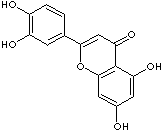PRODUCT IDENTIFICATION

207-741-0
H.S. CODE
TOXICITY
SMILES
c12c(c(=O)cc(o1)c1cc(c(cc1)O)O)c(cc(c2)O)O
CLASSIFICATION
Natural Colorant, Flavone, Antioxidant
EXTRA NOTES
A 3'-hydroxyflavonoid which is thought to play an important role in the human body as an antioxidant, a free radical scavenger, an agent in the prevention of inflammation, a promoter of carbohydrate metabolism, and an immune system modulator.(ChEBI)
PHYSICAL AND CHEMICAL PROPERTIES
>320 C
SOLVENT SOLUBILITY
Soluble in alkalies
REFRACTIVE INDEX
NFPA RATINGS
AUTOIGNITION
FLASH POINT
EXTERNAL LINKS & GENERAL DESCRIPTION
Wikipedia Linking - Luteolin
Google Scholar Search - Luteolin
Drug Information Portal (U.S. National Library of Medicine) - Luteolin
PubChem Compound Summary - Luteolin
KEGG (Kyoto Encyclopedia of Genes and Genomes) - Luteolin
http://www.ebi.ac.uk/ - Luteolin
http://www.ncbi.nlm.nih.gov/ - Luteolin
http://toxnet.nlm.nih.gov/
Hazardous Substances Data Bank - Luteolin
Local
Luteolin is a bioflavonel, considered to have bioactive effect on human health as antioxidant, radical scavenger, anti-inflammatory, carbohydrate metabolism promoter, immunity system modulater. It is considered to play a role in prevention of cancer. Members of luteolin molecules include:
|
Luteolin |
CAS RN |
| Orobol | 480-23-9 |
| Chrysoeriol | 491-71-4 |
| Luteolin | 491-70-3 |
| Nepetin | 520-11-6 |
| Nepitrin | 569-90-4 |
| 5,7,3',4'-Tetramethylluteolin | 855-97-0 |
| Homoorientin |
4261-42-1 |
| Luteolin-7-glucoside | 5373-11-5 |
| 6-Hydroxyluteolin | 18003-33-3 |
| Veronicastroside | 25694-72-8 |
| Luteolin glucoside | 26811-41-6 |
| Orientin | 28608-75-5 |
| Luteolin-7-glucuronide | 29741-10-4 |
| Chrysoeriol-7-O-(2''-O-mannopyranosyl)allopyranoside | 137809-96-2 |
| Luteolin-4'-O-(rhamnopyranosyl-1-2-glucopyranoside | n/a |
| Luteolin 7-O-glucoside 4''-sulfate |
n/a |
| 6-Hydroxyluteolin-7-O-glucoside |
n/a |
| Luteolin-7-glucuronide |
n/a |
| Luteolin 4'-O-glucoside |
n/a |
| 6-Hydroxyluteolin-7-O-(1''-rhamnoside) |
n/a |
| Luteolin-7-galactoside |
n/a |
| Luteolin-7-glucopyranosyl-1-6-glucoside |
n/a |
| Luteolin 5-O-beta-rutinoside | n/a |
| Luteolin-7-glucopyranosyl-1-2-glucoside |
n/a |
| Luteolin-7-O-beta-D-glucuronide | n/a |
| Luteolin 7-O-beta-D-apiofuranosyl-(1-2)-beta-D-glucopyranoside |
n/a |
| Luteolin 3'-glucuronide |
n/a |
| Luteolin-7-glucuronide methyl ester |
n/a |
| Luteolin 8-C-rhamnoside-7-O-rhamnoside |
n/a |
| Scolymoside |
n/a |
| Luteolin-7-glucuronide ethyl ester |
n/a |
| luteolin 7-O-(glucuronosyl-1-2-glucuronide) | n/a |
Luteolin is classified as an ingredient of expectorant which ejects phlegm or other material from the throat or lungs by decreasing its viscosity or stimulating secretion of mucus by the respiratory tract mucosa.
APPEARANCE
ASSAY
98.0% min
MELTING POINT
>320 C
GENERAL DESCRIPTION OF FLAVONOID
- Flavonols (Hydroxy derivatives of flavone): Fisetin, Galangin, Kaempferide, Kaempferol, Morin, Myricetin, Myricitrin, Quercetin, Quercetrin, Rhamnetin, Robinin, Rutin, Spirenoside
- Flavones (skeleton: 2-phenylchromen-4-one): Apigenin, Baicalein, Chrysin, Diosmetin, Diosmin, Flavone, Luteolin, Rpoifolin,Tangeretin, Techtochrysin, Rhamnazin, Nobiletin, Natsudaidain.
- Isoflavones (skeleton: 3-phenylchromen-4-one): Daidzin, Genistein, Irilone, Luteone, Prunetin, Pratensein,
- Flavonones (derivation by reduction of the 2(3) C=C bond): Eriodictyol, Hesperidin, Hesperetin, Likvirtin, Naringin; Naringenin; Pinocembrin
- Flavanols (derivation by reduction of the keto group):(+)-Catechin, (+)-Gallocatechin, (-)-Epicatechin (EC), (-)-Epigallocatechin (EGC), (-)-Epicatechin 3-gallate (ECG), (-)-Epigallocatechin 3-gallate (EGCG), Theaflavin, Theaflavin 3-gallate, Theaflavin 3'-gallate, Theaflavin 3,3' digallate, Thearubigins
- Anthocyanidins (aglycones of the glycoside anthocyanins): Apigeninidin, Cyanidin, Delphinidin, Diosmetinidin, Guibourtinidin, Fisetinidin, Luteolinidin, Malvidin, Pelargonidin, Peonidin, Robinetinidin, Tricetinidin, Capensinidin, Petunidin, Europinidin, Aurentinidin, Columnidin, 5-Desoxy-malvidin, 5-Desoxy-peonidin, Hirsutinidin, Rosinidin.
HAZARD OVERVIEW
Causes skin irritation. Causes serious eye irritation. May cause respiratory irritation.
GHS
Warning
PICTOGRAMS

HAZARD STATEMENTS
H315-H319-H335
P STATEMENTS
P261-P305 + P351 + P338
![]() Xi
Xi
RISK PHRASES
36/37/38
SAFETY PHRASES
26-36
PRICE INFORMATION